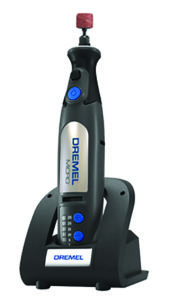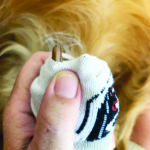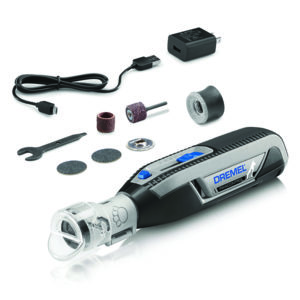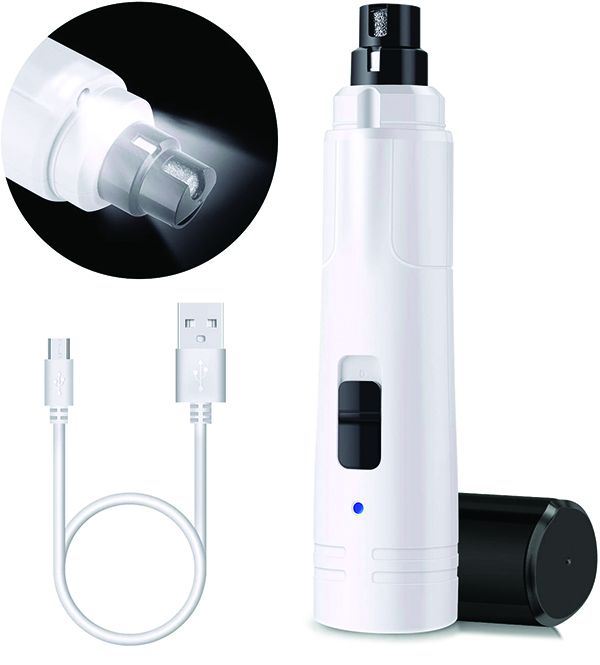There are dozens of grinding tools on the market – products specifically for trimming dogs’ nails, as well as rotary tools designed for woodworking or other projects. We polled a dog trainers’ group – people who habitually trim their own dogs’ nails – about the type and models of grinders they like best: Which products consistently get four tidy-nailed paws up for usability and effectiveness?
The consensus was that while the dog-specific rotary grinders are quieter, they take much longer to reduce the dogs’ nail length, especially on breeds with thicker nails. However, a few people said they find the grinders branded for use on dogs to be useful when initially training young or fearful dogs to tolerate nail trimming or for small breeds with thinner nails.
ENTRY-LEVEL DOG-SPECIFIC GRINDER
A quick search on Amazon reveals dozens of dog-specific nail grinders to choose from. Most all of them have a low-profile plastic guard covering the grinding bit. The plastic guard has a cut-out area that exposes just a small portion of grinding surface, and this is where you position the nail.
While I like that the presence of a guard appears to prevent the hair of a dog with a long coat (or the human operator’s hair) from accidentally getting wrapped around the quickly spinning tool head, it does seem to require better aim to get and keep the nail aligned with the cut-out. We noticed the guard on some products is removable in order to accommodate larger nails or for faster filing.
A good entry-level pet-specific grinder is the best-selling Casfuy Upgraded Professional Two-Speed Pet Nail Grinder, which sells on Amazon for $30. Note that the two speeds are both relatively low: 7,000 and 8,000 revolutions per minute (RPM).
A pet-specific grinder might be a nice addition to your toolbox, if you’re working with a breed with thin nails, or young, small, or fearful dogs, or you’re brand new to grinding and don’t want to start with a higher-power tool. If your dog has thick nails and/or you feel confident you can safely handle more power, it’s worth stepping up to a multi-purpose rotary tool.
HOBBYIST’S ROTARY TOOLS

When it comes to rotary tools that are not made specifically for pet nails, our panelists agreed on a top pick: The Dremel 8050 Micro. This grinder runs on an 8-volt rechargeable lithium battery. The tool features five variable speeds ranging from 5,000 to 25,000 RPM. Note that 5,000 RPM is too slow to accomplish much grinding and that 25,000 RPM will get the nail too hot too quickly. Overall, this product is quieter than older models – a plus for working with dogs.
Three features help give the 8050 its top ranking:
✓ The LED light that’s built into the tool’s nose cap (this illuminates the nails as you work – brilliant!).
✓ The docking station that keeps the tool fully charged and ready for use.
✓ If caught on something, the tool automatically stops.

This last point is especially important when working with long-coated dogs or if you have long hair. (Pro tip: If your dog has hairy feet, try snipping a tiny hole in the end of a baby sock or nylon stocking. Cover the paw with the sock or stocking and use it to keep the dog’s long hair at bay. Don’t forget to pull your own long hair back, too!)

Dremel also offers a clear plastic “nail guard” attachment that clips onto a variety of its rotary trimmers. The guard is said to help achieve a 45-degree angle for trimming, manage nail dust, and hold a long-haired dog’s fur out of the way. If you already have a Dremel but aren’t comfortable using it, the Pet Grooming Nail Guard might make for nice “training wheels.” The guard is sold individually as the “AT01-PGK Pet Grooming Nail Guard,” but costs almost as much ($33!) as a kit that includes the guard and a Dremel 7760 rotary tool ($47 on Amazon.com). Get the kit if you don’t already have a rotary tool and like the idea of using a guard.
Related Article
Grinders vs. Clippers: What’s Best for your Dog’s Nails?







As a professional groomer with 30 years experience with all breeds of companion, performance and show dogs I am often amused by the advice given by WDJ regarding grooming. Rarely is this advice given by groomers, in this article a group of dog trainers(?) were polled regarding their recommendations for nail grinders. While there is a behavioral component to all dog grooming activities, there is also a lack of systematic product testing and comparison that a professional groomer would do and often the most obvious solution is completely overlooked. I recommend to my own clients who want to work on their dogs’ nails between grooming appointments a course nail file (for acrylic nails,) much better for a novice than any grinder. These are inexpensive (about $2.00 at any drug store or supermarket,) simple to use, and not nearly as frightening to the dog as ANY motorized tool. It’s also much easier to conquer the learning curve and avoid bleeding the nail without expert instruction. The process is necessarily slower and requires some patience at first, but any dog that can tolerate handling of the feet can tolerate filing her nails. Once the owner knows what to do a file can get the job done almost as quickly as a grinder with much less stress for both the owner and dog.
I get my labs nails done at the groomers and they use a grinder, I feel more confident with a professional doing his nails, I don’t need the stress of wondering if I’m doing it like a trained professional and I can imagine my dog isn’t pleased with the process but when he walks out he’s seems pretty chill, a small price to pay when he still looks at me like I’m his hero 🙂
I was always scared of using clippers because of previous bad experiences trimming black nails. Our current dog has mostly white nails which make it much easier to see the quick. I started grinding with a cheap, pet-specific tool but went for the Dremel 8050 when it was on sale. The light is incredibly helpful in seeing through the nail to where the quick is.
There’s a group on Facebook that teaches you how to do nail maintenance on dogs. There are many lessons but the most important may be learning how to approach it in a stepwise manner, teaching your dog that nails trims are positive experiences. It can take quite a while to get there, but once it happens, it’s practically magic. Now when I get the grinder out, my dog runs to his bed and gets into position, ready to go.
Another alternative to clipping and grinding is a scratch board. Basically, you train your dog to file their own nails! That same Facebook group has information on how to make one.
What is the Facebook group name? Thanks for the info
Hi there what machine is good for trimming the nails?